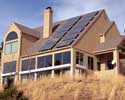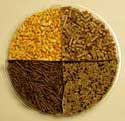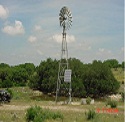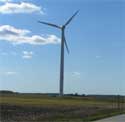Renewable Energy Tools
Renewable energy can be used to displace electricity, water heating or space heating with fossil fuels. Using renewable fuel also reduces greenhouse gas emissions and conserves the use of fossil fuels. These tools will help estimate the energy production from solar photovoltaic panels, solar hot water panels, wind turbines, biogas from anaerobic digesters and biomass such as wood, wood pellets, corn and prairie grass pellets. Before investing in renewable energy production, it is usually more cost effective to invest in energy conserving equipment and processes to reduce your energy demands as much as possible. This has the added benefit of reducing the size and investment cost of renewable energy technologies.
Renewable Spotlights
 Solar Water Heating
Solar Water Heating
Solar panels can harvest the sun to heat water for many different uses including heating swimming pools, domestic hot water or space heating. There are several types of systems and solar panels that the first section of the tool will describe. The assessment tool will calculate the size and approximate cost of a system to displace 50% of your hot water use.
 Solar PV (Electric)
Solar PV (Electric)
The solar PV (electric) energy tool was developed to increase renewable energy awareness and utilization in agriculture. Solar electric systems, often referred to as photovoltaic or PV systems, can provide reliable electricity for a home, farm or business. The Solar PV energy calculator is designed to estimate the size of a solar electric system according to either the amount of electricity you would like to generate or the maximum investment you are willing to make.
 Biogas/Anaerobic Digestion
Biogas/Anaerobic Digestion
The biogas energy tool was developed to increase awareness and utilization of anaerobic digestion processes and renewable energy production in agriculture. Biogas can be used for generating electricity, thermal heating or cleaned and sold as renewable natural gas. The biogas self assessment tool will assist farm producers in evaluating their farm’s potential for producing biogas to generate electricity, and will assist producers in determining biomass feedstocks that are available on-farm.
 Biomass Combustion
Biomass Combustion
The biomass energy tool considers the cost effectiveness of using biomass fuels such as cord wood, corn, rye, wood pellets or prairie grass pellets to fuel a furnace or boiler versus using fossil fuels. The tool evaluates the annual cost of a variety of biomass fuels based on the amount of heat you would like displaced by the chosen biomass fuel compared to a fossil fuel.
 Solar-Wind Water Pumping
Solar-Wind Water Pumping
Water pumping can be done using Solar PV (electric) or water pumping windmills. Water pumping
windmill were used widely to supply water during westward expansion of United States for livestock
and people until rural electrification when many people replaced the windmills with electric water
pumps. In remote areas Solar PV and/or water pumping windmills are and can still be used. If you
travel through the Kansas Flint Hills or other prairie areas where cattle are still pastured, the
landscape is dotted with American style windmills for supplying water. The water pumping tool will
provide an estimate of the minimum size of solar PV system or diameter of windmill and pump size to
supply the amount of water specified.
 Wind
Wind
The wind energy tool can calculate the energy produced from a particular size turbine, calculate the turbine size base on the amount of desired energy production or calculate the energy production and turbine size based on the amount of money available to invest in a wind power system.

